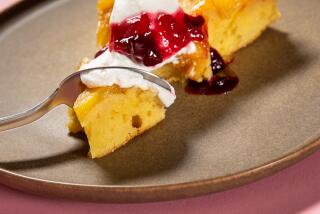The Elusive Pineapple
- Share via
The true Latin name of the pineapple is Ananas comosus , but “Pineapplea elusiva” might be a better moniker in the continental United States, where examples that live up to expectations are rare. Because they do not continue to develop sugars after they are cut, only pineapples that are picked fully ripe have the rich fragrance and abundant sweetness that led to their original name in the Guarani language of South America: nana , “excellent fruit.”
A fully ripe pineapple is tender and easily bruised and does not keep well, so even those destined for air shipment are generally harvested several days short of readiness, before the last, very large surge of sugar has come from the stem to the fruit.
Produce managers are fond of saying that pineapples will ripen if you take them home and keep them in a warm place for a few days, and most of us do buy them as we buy pears--assuming they’ll take a while to achieve best eating quality. The truth is, they do improve, but only because they soften and some of their acidity dissipates. This makes them taste riper and sweeter in a comparative sort of way, but that’s it.
Nevertheless, tasty if not splendid is well within the range of possibility, and a tasty raw pineapple is splendid when compared to a canned one. The trick is getting to tasty. Pineapples give precious few outer indications of what lies within.
Produce maven Elizabeth Schneider, who wrote the authoritative “Uncommon Fruits and Vegetables,” says “I go simply by aroma--if it’s got some intensity, it’s got a running chance. If there’s no aroma, you can bet there will be no flavor.” The place to sniff is the stem end and the time to sniff is when the pineapple is warm. Even a good fruit will give off little perfume if it’s cold. Beware of any sour or fermented smell, always an indication that decay has set in.
The famous tuft test (pull on an inner leaf--if it comes out readily, the pineapple is ripe) doesn’t prove very much, but a good look at the leaves is wise. They should be fresh-looking, firm and green. The fruit itself should not be firm and green, but slightly yielding and at least tinged with yellow or reddish brown. Different varieties are different colors at full ripeness, but none of them is that dismal automobile green so common at produce displays.
Schneider also plumps for heavy pines; like grapefruits they will be juicier if they are weighty for their size. Large pineapples generally have more usable flesh in proportion to skin and core, so though they are often more expensive than small ones it works out about the same on a per serving basis.
When you do get a tasty pineapple, the thing to do is eat it, gratefully. When tastiness is marginal, sprinkle lightly with sugar and let it sit for a while. It doesn’t take very much added sugar to bring out the best in the fruit. Or use the pineapple with fat meat such as pork or duck. The sharpness of the taste is a pleasant contrast and the special enzyme that breaks down protein--the one that keeps gelatin from setting--will make the meat more tender and digestible.
Pineapple Upside-Down Cake is as classic as devil’s food, and with almost as many variants as the old-fashioned chocolate favorite. This recipe is a hybrid, combining suggestions for ingredients and technique from many sources, principal among them Rose Berenbaum’s “Cake Bible” and Jane Grigson’s “Fruit Book.”
Grigson labeled her dessert a pudding, which helps explain why upside-down cakes seem to be such comparatively late arrivals in American cookbooks. Fruit baked with batter on top, turned upside down for serving, is an idea that has been around for a while; it’s just that it started out really happy, over in the pudding section.
PINEAPPLE UPSIDE-DOWN CAKE
13 tablespoons unsalted butter
1/3 to 1/2 cup brown sugar, packed
1 medium pineapple, cut in 1/3-inch slices, core removed if woody
Brandied cherries, plumped dried apricots or toasted hazelnuts or pecans, optional
1/2 cup sour cream
2 eggs
2 egg yolks
1/2 cup almonds
1 cup sugar
1 1/2 cups sifted cake flour
2 teaspoons baking powder
1/4 teaspoon baking soda
Melt 3 tablespoons butter in heavy, 10-inch skillet. Swirl pan so butter comes up sides. Stir in brown sugar and remove skillet from heat. When cool, arrange pineapple and optional decor in pattern that completely covers bottom and sides of pan.
Place 2 tablespoons sour cream in small mixing bowl. Beat in eggs and yolks. In food processor, combine almonds and sugar and grind until almonds are very fine. Add flour, baking powder and baking soda and process just long enough to blend. Cut remaining butter into 5 or 6 pieces and process in. Add remaining sour cream and process until batter is smooth.
Whip egg mixture in 3 batches, giving each about 20 seconds processing time. Turn batter onto prepared pineapple bed and smooth top, spreading toward sides. Bake at 350 degrees about 45 minutes or until wood pick inserted in center comes out clean and cake is beginning to shrink from sides of pan.
Cool about 5 minutes, then reverse onto large, heat-proof cake plate. Or reverse cake onto baking sheet, then use pancake turners to transfer to serving dish. Makes 9 servings.
More to Read
Eat your way across L.A.
Get our weekly Tasting Notes newsletter for reviews, news and more.
You may occasionally receive promotional content from the Los Angeles Times.






